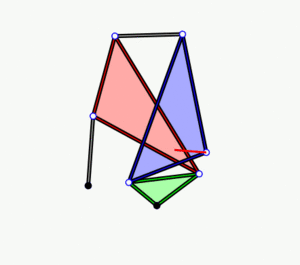Alfred Kempe facts for kids
Quick facts for kids
Sir Alfred Kempe
|
|
|---|---|
 |
|
| Born | 7 July 1849 Kensington, London, England
|
| Died | 21 April 1922 (aged 72) London, England
|
| Known for | Kempe chain Kempe's universality theorem Sylvester-Kempe inversor |
| Awards | Fellow of the Royal Society (1881) |
| Scientific career | |
| Influenced | Charles Sanders Peirce |
Sir Alfred Bray Kempe (born July 6, 1849 – died April 21, 1922) was a clever mathematician from England. He is best known for his work on "linkages" (which are like connected rods that move) and his ideas about the "four colour theorem." This theorem is a famous puzzle about colouring maps.
About Alfred Kempe
Alfred Kempe was born in London, England. His father was a church leader. Alfred went to St Paul's School, London and then studied at Trinity College, Cambridge. There, a famous mathematician named Arthur Cayley was one of his teachers.
After college, Kempe became a barrister, which is a type of lawyer. He specialized in church law. He was made a "Sir" (knighted) in 1913. He also became a "Chancellor" for the Diocese of London. This is a senior legal role within the church.
Kempe's Amazing Discoveries
In 1876, Kempe wrote an important paper about how to use linkages to draw complex shapes. Imagine connecting several rods with hinges. Kempe showed how to build these linkages to draw almost any flat shape you can think of. This idea is now called Kempe's universality theorem. Even though his first proof had a small mistake, his ideas were very important and were fully proven later.
In 1877, Kempe found a new type of linkage that could draw a perfectly straight line. It's called the Quadruplanar inversor or Sylvester–Kempe Inversor. He also wrote famous lectures about this topic.
Kempe is also well-known for his work on the four colour theorem. This theorem asks: can you colour any map using only four colours so that no two neighbouring countries have the same colour? In 1879, Kempe thought he had proven it, but another mathematician, Percy Heawood, found a small error in 1890. Even so, Kempe's work led to important ideas like the Kempe chain, which are still used in mathematics today.
Kempe also discovered what are now called multisets. These are like sets of items, but where items can appear more than once. This idea was not fully recognized until much later.
Awards and Hobbies
In 1881, Kempe was chosen as a Fellow of the Royal Society. This is a very high honour for scientists. He was also the Treasurer and Vice-President of the Royal Society for many years. From 1892 to 1894, he was the president of the London Mathematical Society.
Besides his work, Kempe was also a keen mountain climber, especially in Switzerland.


